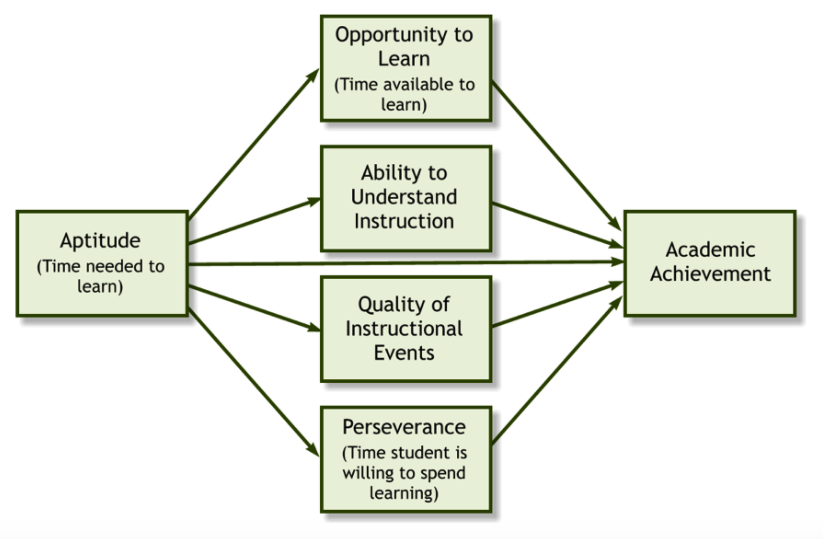Could I use this?

John Carroll
Given the student profile, do I end up giving some of them or all of them the opportunity to learn in the time available? Knowing the potential group would it be better to split the group, rather than trying to cater for everyone all in one go? Self-paced learning can overcome this by signalling the choices a visitor to web content might take: fonts, graphics and image choices indicate the age range and for two extremes, kids with a brightly promoted online colouring book can be differentiated from parents in the know who are offered academic papers in the form of a link to a PDF to read.
There can only be ONE thread in a live classroom. In self-paced learning you can branch it, so letting a student find the way that is best suited to their knowledge, understanding and desired pace.
In 15 minutes there is little need for perseverance.
Achievement is the witness of the 'before' plate from the 'after' plate.
There are six elements to Carroll's model: (1)
Academic Achievement: the outcome
Aptitude: The "the amount of time a student needs to learn a given task, unit of instruction, or curriculum to an acceptable criterion of mastery under optimal conditions of instruction and student motivation" (Carroll, 1989: 26). "High aptitude is indicated when a student needs a relatively small amount of time to learn, low aptitude is indicated when a student needs much more than average time to learn" (Carrol: 1989: 26).
Opportunity to Learn: i.e. the amount of time available for learning (classwork, homework and private study). Carroll (1998:26) notes that "frequently, opportunity to learn is less than required in view of the students aptitude". Slow down. Take your time. Pace it. Provide opportunities for questions, feedback and going over something multiple times. (Where digital resources come into their own).
Ability to Understand Instruction: This relates to learning skills, information needed to understand, and language comprehension. Know your students before. Get to know them during.
Quality of Instruction: Plan the lesson with your students in mind. Follow Gagne's nine general steps of instruction for learning (2).
- Gain Their Attention
- Describe the goal. Remember to state the Learning Objectives i.e. what they will learn and what they can do with it.
- Stimulate Recall. Prior knowledge based on past classes, conversations and student profiles
- Present the materials to be learned. Chunk information to avoid memory overload.
- Provide 'guidance for learning' > present rather than instruct
- Elicit Performance 'practice' > get the students to do something.
- Provide information feedback > analyse learners' behaviour.
- Assess performance > any simple indication that progress is being made
- Enhance retention and transfer > look for similar problem situations, give more practice.
Perseverance: Amount of time a student is willing to spend on a given task or unit of instruction. This is an operational and measurable definition for motivation for learning.
REFERENCE1) Reeves, TC, & Reeves, PM (1997). A model of the effective dimensions of interactive learning on the World Wide Web.
2) Gagne, Robert M., Briggs, Leslie, J., Wager, Walter, F. (1985). Principles of Instructional Design, Wadsworth, ISBN 0030347572
Carroll model of school learning
Carroll, J. B. (1963). A model of school learning. Teachers College Record, 64, 723-733.